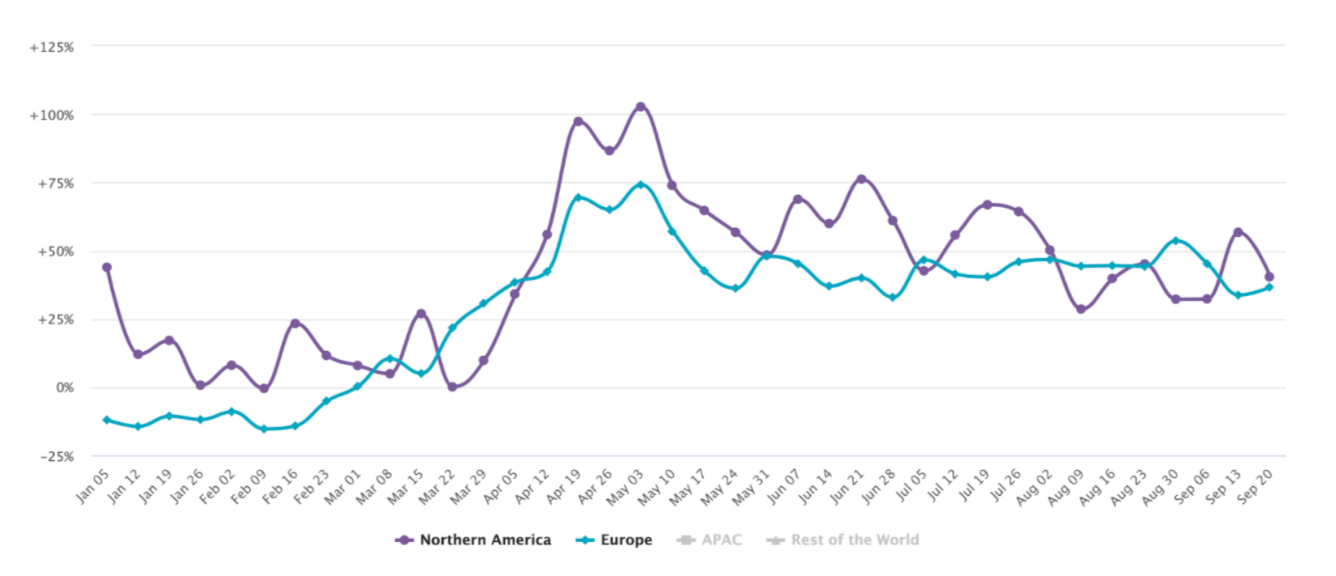
Why Black Friday 2020 will be different
Black Friday and Cyber Monday are approaching fast, launching the major holiday sales season for all players in the e-commerce and retail sector. Demonstrating their importance, Black Friday 2019 generated $7.2 billion in US digital sales and Cyber Monday $9.4 billion according to reports.
But the 2020 edition is shaping up to be unlike any other. Since April, online sales have peaked at previously unseen levels and almost 29% of U.S. consumers (27% of those in the UK) say that they’ll now use digital channels more in the future. With many consumers still wary of returning to brick-and-mortar stores, the shift to digital is taking root on a global scale, making e-commerce crucial to a successful holiday season for retailers. However, at the same time many people are planning to spend less on gifts, according to eMarketer, meaning that competition online will be even fiercer.
In this article, we’ll look at how the digitization of Black Friday and Cyber Monday has accelerated and how to adapt to consumers’ growing expectations with regard to their online experience. How can you encourage both existing customers and new audiences to engage? What opportunities does this unprecedented holiday season bring?
1 Black Friday 2020: a global shift to digital
Due to social distancing rules, this year there will be no emblematic stampedes in big-box stores on Black Friday. Some big brands like Walmart and Target have already announced that their stores will be closed on the day after Thanksgiving. Some other brands have even come up with a lottery system to limit the number of people in-store on Black Friday.
NEW CONSUMPTION HABITS ARE BECOMING ENTRENCHED
The lives and habits of consumers have radically changed since the beginning of the COVID-19 epidemic. According to research by Mood Media, 40% of US consumers say they haven’t yet returned to non-essential retail stores and a further 20% said they are spending less time in physical stores.
Despite lockdowns being lifted, unstable health conditions are contributing to keeping retailers’ online revenues at historically high levels for the season. (Up almost 40% at the end of September 2020 in Europe and North America compared to 2019).

Innovations such as contactless payment systems and preventive health measures don’t appear to be enough to set customers at ease and encourage them all to return to stores.
This is why this year they’ll be choosing the digital channel to find bargains and make their purchases.
The brands that used to favor in-store promotions for Black Friday are now obliged to extend their offering to digital channels. And of course the biggest online retailer of them all – Amazon – has created its own version of Black Friday, with Prime Day happening on October 13/14. To deal with these lasting changes and the current economic turbulence, retailers must rethink their online sales strategy for the long term.
HIGHER EXPECTATIONS AROUND QUALITY AND PERSONALIZATION OF THE DIGITAL EXPERIENCE
The habits of consumers may have changed radically, but this hasn’t made them any less demanding. Brands must be particularly careful to provide them with a digital experience that is equal to an in-store experience on Black Friday.
What are consumer expectations for Black Friday 2020?
- They want free shipping and returns (58%)
- They want the ability to see products in a real setting (38%)
- They require fast shipping (37%)
- They demand smooth and simple payment processes (35%)
Loyalty and personalization are also priorities:
- 38% of consumers wait for Black Friday to receive great offers that reward their loyalty
- 20% expect to receive more personalized promotional offers and communications from brands
Market research conducted in September 2020 among US, British and French consumers.
Throughout their online journey on Black Friday, consumers will expect the following from brands:
- a wide range of products and seamless navigation: whether it’s to search for a product, check the contents of their cart, or pay for their purchases, consumers want an intuitive and coherent journey, regardless of the device they’re using.
- clear information about purchasing and shipping conditions
- for products: particularly for categories that require advice and support (such as electrical goods and technology).
- for delivery: around time frames, delivery providers or return conditions.
- benefits to reward their loyalty: it is much easier for consumers to switch brands online compared to in-store. After all, product or service comparison tools are just a click away. This is why many consumers want to be rewarded for their loyalty, especially on Black Friday.
E-commerce websites must prepare for Black Friday 2020 by leveraging a quality relationship with their customers. It’s a unique opportunity to make a good impression on your visitors, particularly the new e-consumers attracted by your promotional deals or who have moved online due to the pandemic.
2 How to create the conditions for a successful digital Black Friday
With lower in-store footfall (and many retailers not opening physical locations at all), web traffic should reach historic levels over the Thanksgiving period. To provide an exceptional experience on Black Friday, brands must optimize their visitors’ digital journey. This involves multiple areas:
Guaranteeing a smooth purchasing experience
Firstly, you must optimize your e-commerce website, regardless of the device your visitors are using. To highlight the range of your product catalog and enable visitors to easily make purchases, it is vital to maximize the impact of the different elements of your website: the homepage, menu, banners, pop-ins, etc.
With A/B testing, you can optimize your overall website to ensure there is no friction during your visitors’ journey. However, that is just a start. It’s also vital to provide an experience that meets the specific expectations of each and every visitor by personalizing their visit.
Addressing relevant offers and messages to your visitors
The range and number of offers during the Black Friday period can overwhelm consumers. By personalizing the digital experience based on their profile or behavior and conversion intention, you can help highlight items of interest, build trust and maximize your conversion rates.
For example, it’s possible for fashion retailers to display sale items available in a consumer’s size: by personalizing their search, you not only save them time, you also increase their chances of converting.
To go further, you can download our dedicated retail ebook to read best practice advice from out clients and consultants on how to provide a tailored experience to consumers.
You can also take the personalization of your visitor experience further tailoring your discount coupon strategy. With the help of a predictive algorithm like Kameleoon’s, it’s now possible to identify hesitant visitors and offer them a personalized discount in real-time. AI enables you to replicate the personal advice provided by an in-store sales associate but online and at scale. This has an immediate effect on your sales revenues, while maintaining your margins as discounts are targeted at the right consumers.
Additionally, by segmenting your audience you can ensure your visitors only see relevant messages. For example, for Black Friday, you could use an urgency-inducing message in the form of a countdown to let consumers know when a promotion on an item is ending: “You have 9 hours and 34 minutes to take advantage of this offer.”
Informing and reassuring your consumers
Without being able to go into stores, some consumers may feel lost. For instance, how can they decide if an item of baby clothing runs large or small? Or if the material of a travel bag is as resistant as they wanted? Brands must be able to provide advice, even remotely.
Consumers who have recently converted to digital will pay particular attention to the info boxes and tooltips listing the benefits and characteristics of your products. Make every effort to highlight what makes your product attractive. Consumers will also respond well to reviews from existing customers, via social proof messages such as “Our customers love it! Overall rating 4.5/5”
Building loyalty and rewarding your visitors
An event like Black Friday is a golden opportunity to maintain and expand the number of members in your loyalty program. For instance, you can reward your regular customers by offering them early-bird access to your Black Friday specials, giving them the chance to accumulate extra points leading to additional benefits, or even providing them with access to VIP services such as free returns or the chance to exchange goods more quickly.
Preparing a smooth shipping experience
The lockdown taught e-commerce players many important lessons about product shipping and availability. Brands were caught short in during the early days of the pandemic and had to urgently adapt their delivery systems. Many had to post reassurance messages to keep customers updated about longer delivery times and exceptional stock shortages (through inserts, banners or info boxes on product pages, for example). With Black Friday only a few weeks away, most brands are already organized to deal with the surge in demand by offering a range of shipping options, from home delivery to click & collect/BOPIS, e-reservation or in-store appointments. Consumers want choice and they want to be able to pick the solution that particularly suits them.
Consequently, brands must optimize their website to make sure that they can see all relevant information related to shipping. By using AI, you will also be able to identify the delivery options that best suit your individual visitors, based on their previous behavior and factors such as location.
3 Finding new opportunities in Black Friday 2020
The acceleration of Black Friday’s switch to digital channels is set to continue and provides real growth prospects for retailers:
- A significant influx of new visitors on e-commerce websites will give brands the ability to analyze the behavior of their new visitors. This is a chance to provide them with a flawless first experience, with the aim of turning them into loyal customers.
- Brands that were not previously very digitally mature have learnt a great deal following the lockdown. Black Friday is the perfect opportunity to consolidate their new knowledge and continue to improve their digital performance.
- For companies who struggled to sell their products during lockdown, Black Friday represents a vital chance to clear their stock at attractive prices.
- Finally, like all major digital events, the Black Friday period is an opportunity to test, learn and improve.
One thing is certain: Black Friday 2020 will take place overwhelmingly on the web and not in shopping malls. This means that, more than ever, brands need to provide their visitors with a seamless, personalized purchasing experience if they are to make this end-of-year peak an opportunity to boost conversions and sales revenue.




